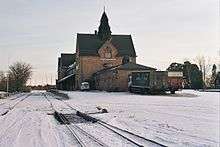Haparanda Line
The Haparanda Line (Swedish: Haparandabanan) is a 165-kilometer (103 mi) long railway line between Boden and Haparanda in Sweden. There is a 3-kilometer (1.9 mi) long section from Haparanda to Torneå, which is on the Finnish side of the Finland–Sweden border. The line is the only Swedish railway to the Finnish border. The single track line is used exclusively by freight trains. Passengers must use buses from Luleå to the Haparanda bus station, where there are bus connections to Kemi in Finland. Interrail tickets are valid on these buses.

History
Haparanda Line | ||||||||||||||||||||||||||||||||||||||||||||||||||||||||||||||||||||||||||||||||||||||||||||||||||||||||||||||||||||||||||||||||||||||||||||||||||||||||||||||||||||||||||||||||||||||||||||||||||||||||||||||||||||||||||||||||||||||||||||||
|---|---|---|---|---|---|---|---|---|---|---|---|---|---|---|---|---|---|---|---|---|---|---|---|---|---|---|---|---|---|---|---|---|---|---|---|---|---|---|---|---|---|---|---|---|---|---|---|---|---|---|---|---|---|---|---|---|---|---|---|---|---|---|---|---|---|---|---|---|---|---|---|---|---|---|---|---|---|---|---|---|---|---|---|---|---|---|---|---|---|---|---|---|---|---|---|---|---|---|---|---|---|---|---|---|---|---|---|---|---|---|---|---|---|---|---|---|---|---|---|---|---|---|---|---|---|---|---|---|---|---|---|---|---|---|---|---|---|---|---|---|---|---|---|---|---|---|---|---|---|---|---|---|---|---|---|---|---|---|---|---|---|---|---|---|---|---|---|---|---|---|---|---|---|---|---|---|---|---|---|---|---|---|---|---|---|---|---|---|---|---|---|---|---|---|---|---|---|---|---|---|---|---|---|---|---|---|---|---|---|---|---|---|---|---|---|---|---|---|---|---|---|---|---|---|---|---|---|---|---|---|---|---|---|---|---|---|---|---|
| ||||||||||||||||||||||||||||||||||||||||||||||||||||||||||||||||||||||||||||||||||||||||||||||||||||||||||||||||||||||||||||||||||||||||||||||||||||||||||||||||||||||||||||||||||||||||||||||||||||||||||||||||||||||||||||||||||||||||||||||
The railway from Boden to Haparanda was built in several sections over the course of 17 years. The first segment to be completed was Buddbyn to Niemisel in 1900, followed by the segment Niemisel to Morjärv in 1902. The railway did not reach Lappträsk until in 1910, and the Swedish–Finland border at Karungi on the west bank of Torne River was not reached until 1913.
Karungi was to become a junction, and the railway reaching northward to Övertorneå was built in 1914, followed by the southern Karungi to Haparanda line in 1915. The only open railway connection between Germany and Russia during World War I went here. Lenin traveled here in 1917[1] to organise the Russian Revolution. The bridge over the Torne River between Haparanda and Tornio was placed in service in 1919. Before that passengers had to walk or use horse carriages the short distance between the cities.
The station building was finished in 1918, and was dimensioned based on the traffic during the war. All international travelers had to change trains here because of the break-of-gauge, and had to go through passport check. During World War II, the traffic was dense again since the Baltic Sea was not safe. It is one of Sweden's largest station buildings, but not used at the moment.
The branch line from Morjärv towards Kalix was built in 1961. Traffic between Karungi and Övertorneå was discontinued in 1984, and the line was torn up soon thereafter. In 1986 a more direct route was built between Övermorjärv and Östra Flakaträsk, bypassing the Räktjärv station. The old line along with one bridge was demolished soon after the new shortcut was built; however, the old line is still visible on many Swedish maps.
Passenger traffic ended in 1992. The connection to the Finnish trains was already broken in 1988 when the Haparanda–Tornio–Kemi trains were discontinued. There was a test with tourist traffic between Boden–Haparanda in the summer 2000, but it has not been repeated since.
During the period 2007 to 2012, the line from Buddbyn (near Boden Central Station[2]) to Morjärv and Kalix was upgraded, and an alternate route from Kalix to Haparanda was built. The line was electrified in the same time.[3] The old line from Morjärv over Karungi to Haparanda was abandoned in 2012. In 2013, the ETCS (level 2) signaling system was introduced on the line.[4]
The new updated line has made passenger trains to Haparanda more likely[5] and Norrtåg is planning to start operate trains Luleå-Haparanda.
See also
References
- The Vladimir Lenin article has more details and references
- "Haparandabanan". Järnväg.net. Retrieved 19 November 2010.
- "Railway Gazette: News in Brief". Retrieved 2011-01-02.
- "ETCS goes live to Haparanda". Railway Gazette. 17 January 2014. Retrieved 1 July 2019.
- "Persontrafik på Haparandabanan 2018 – om staten går in med 10,3 miljoner". Retrieved 20 March 2017.
External links
![]()